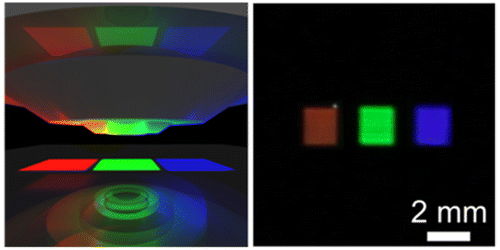Aluminum nanoparticles could improve electronic displays

Whether showing off family photos on smartphones or watching TV shows on laptops, many people look at liquid crystal displays (LCDs) every day. LCDs are continually being improved, but almost all currently use color technology that fades over time. Now, a team reports in ACS Nano that using aluminum nanostructures could provide a vivid, low-cost alternative for producing digital color.
Conventional color technology used in displays is susceptible to photobleaching, or fading. So researchers have looked toward aluminum nanoparticles that can display colors in electronics, thanks to a property called 'plasmon resonance.' To create plasmonic color devices, researchers group nanostructures into arrays called pixels. Color is generated by scattering light onto the pixels, with different arrangements creating different colors. Aluminum plasmonic pixels are advantageous for use in electronic displays because they are inexpensive and can be made in an ultrasmall size, which can increase image resolution. But these pixels create muted and dull colors. In a recent publication, Stephan Link and colleagues developed a method that allows the red end of the color spectrum to be more vibrant. Now, the same team reports another approach that makes the blue end of the spectrum much more brilliant, too.
The researchers used a three-step design approach to create aluminum nanostructure pixels that exploit 'Fano interference'—an interaction between the plasmon resonance and the pixel's array structure—to produce vibrant blue-end colors. Combining their previous research with this new development, the team was able to create pixels with extremely vivid colors across the entire visible spectrum. The researchers then incorporated a set of red, green and blue pixels into a liquid crystal display that could be electrically turned on and off, demonstrating this work's potential use in commercial flat-panel displays.
More information: Jana Olson et al. High Chromaticity Aluminum Plasmonic Pixels for Active Liquid Crystal Displays, ACS Nano (2015). DOI: 10.1021/acsnano.5b06415
Abstract
Chromatic devices such as flat panel displays could, in principle, be substantially improved by incorporating aluminum plasmonic nanostructures instead of conventional chromophores that are susceptible to photobleaching. In nanostructure form, aluminum is capable of producing colors that span the visible region of the spectrum while contributing exceptional robustness, low cost, and streamlined manufacturability compatible with semiconductor manufacturing technology. However, individual aluminum nanostructures alone lack the vivid chromaticity of currently available chromophores because of the strong damping of the aluminum plasmon resonance in the visible region of the spectrum. In recent work, we showed that pixels formed by periodic arrays of Al nanostructures yield far more vivid coloration than the individual nanostructures. This progress was achieved by exploiting far-field diffractive coupling, which significantly suppresses the scattering response on the long-wavelength side of plasmonic pixel resonances. In the present work, we show that by utilizing another collective coupling effect, Fano interference, it is possible to substantially narrow the short-wavelength side of the pixel spectral response. Together, these two complementary effects provide unprecedented control of plasmonic pixel spectral line shape, resulting in aluminum pixels with far more vivid, monochromatic coloration across the entire RGB color gamut than previously attainable. We further demonstrate that pixels designed in this manner can be used directly as switchable elements in liquid crystal displays and determine the minimum and optimal numbers of nanorods required in an array to achieve good color quality and intensity.
Journal information: ACS Nano
Provided by American Chemical Society



















